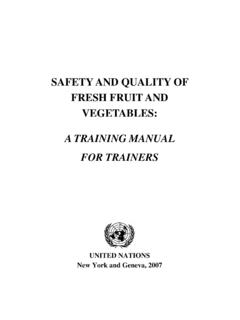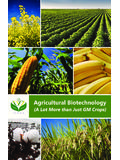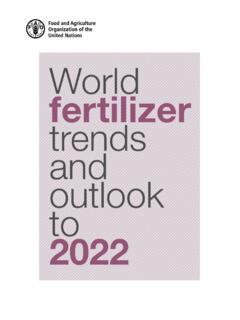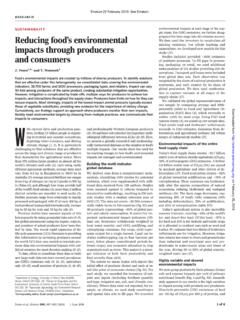Transcription of Conservation Agriculture - Food and Agriculture Organization
1 Conservation AgricultureTraining guide for extension agents and farmersin Eastern Europe and Central AsiaI7154EN/1 978-92-5-131456-2 978 9251314562 Conservation AgricultureTraining guide for extension agents and farmers in Eastern Europe and Central AsiaSandra Corsi and Hafiz MuminjanovFood and Agriculture Organization United NationsRome, 2019 Corsi, S. and Muminjanov, H. 2019. Conservation Agriculture : Training guide for extension agents and farmers in Eastern Europe and Central Asia. Rome, FAO. The designations employed and the presentation of material in this information product do not imply the expression of any opinion whatsoever on the part of the Food and Agriculture Organization of the United Nations (FAO) concerning the legal or development status of any country, territory, city or area or of its authorities, or concerning the delimitation of its frontiers or boundaries.
2 The mention of specific companies or products of manufacturers, whether or not these have been patented, does not imply that these have been endorsed or recommended by FAO in preference to others of a similar nature that are not views expressed in this information product are those of the author(s) and do not necessarily reflect the views or policies of 978-92-5-131456-2 FAO, 2019 Some rights reserved. This work is made available under the Creative Commons Attribution-NonCommercial-ShareAlike IGO licence (CC BY-NC-SA IGO; ).Under the terms of this licence, this work may be copied, redistributed and adapted for non-commercial purposes, provided that the work is appropriately cited. In any use of this work, there should be no suggestion that FAO endorses any specific Organization , products or services.
3 The use of the FAO logo is not permitted. If the work is adapted, then it must be licensed under the same or equivalent Creative Commons license. If a translation of this work is created, it must include the following disclaimer along with the required citation: This translation was not created by the Food and Agriculture Organization of the United Nations (FAO). FAO is not responsible for the content or accuracy of this translation. The original [Language] edition shall be the authoritative mediation relating to disputes arising under the licence shall be conducted in accordance with the Arbitration Rules of the United Nations Commission on International Trade Law (UNCITRAL) as at present in materials. Users wishing to reuse material from this work that is attributed to a third party, such as tables, figures or images, are responsible for determining whether permission is needed for that reuse and for obtaining permission from the copyright holder.
4 The risk of claims resulting from infringement of any third-party-owned component in the work rests solely with the , rights and licensing. FAO information products are available on the FAO website ( ) and can be purchased through Requests for commercial use should be submitted via: Queries regarding rights and licensing should be submitted to: photos: H. MuminjanovPrinted in ItalyiiiContentsForeword ..viiAcknowledgements ..viiiAbbreviations and acronyms ..ixHow to use this Introduction ..12. The need for change sustainable production intensification .. Soil health related to sustainable Agriculture .. Objectives of soil and land management for sustainable Agriculture ..173. Conservation Agriculture objectives, principles, practices .. Constraints and solutions to the introduction and adoption of Conservation Agriculture .
5 274. Equipment and machinery in Conservation Agriculture .. Weed management .. Crop residue and growth management .. No-till seeding ..415. Operations in Conservation Agriculture systems .. Crop residue management .. Pre-seeding cover crops and weed management .. No-till seeding .. Post-planting operations .. Phytosanitary management .. Nutrient management ..656. Designing cropping systems for specific goals .. Cover crops characteristics .. Fitting cover crops in the cropping system ..827. Recommendations for adoption and promotion of Conservation Agriculture .. A whole new system of production .. Farmer Field School an example of knowledge extension ..938. Appendices ..95 Bibliography ..97 Glossary ..100 Annex 1. Characteristics of the main field crops in Eastern Europe and Central Asia.
6 103 Annex 2. Characteristics of cover crops suitable for Eastern Europe and Central Asia ..105 Annex 3. Cover-crop-based successions and rotations suitable for Eastern Europe and Central Asia ..114 Annex 4. FAO Environmental and Social Management Guidelines Environment and Social Standard 5 (E&SS5): Pest and Pesticide Management ..119ivFigures1. Farmers participating in a field day demonstration, Tajikistan ..32. Example of slope erosion leading to gradual degradation of the soil ..73. Crop residues in a field under Conservation Agriculture : farmers need to get used to untidy fields, Republic of Moldova ..84. Soil organisms ..165. Mycorrhizal fungi ..206. Three principles of Conservation Agriculture ..267. Oat and pea mixtures for production of high-quality feed, weeds suppression and recycling of nutrients in the soil.
7 308. Cucumber relayed in maize to control weeds ..309. Soil protected by wheat residues, Tajikistan ..3310. Roller-crimper flattening cover crops, Tajikistan ..3811. Herbicide application with boom sprayer, Turkey ..3912. Soybean harvesting and plant residues spreading across the field, Kazakhstan ..4013. No-till seeding with a jab planter, Tajikistan ..4114. Li-seeder ..4215. Animal-drawn seeders ..4216. Single-axle walking tractor ..4317. Penetration/depth control mechanism ..4518. Components on a row crop furrow opener unit ..4619. Schematic drawing of the seed placement mechanism of a no-till planter ..4720. Chisel type furrow openers for fertilizer ..4821. Double disc type furrow openers for fertilizer ..4822. Snow trapped by standing crop residues, north Kazakhstan ..5323. Maize seeding at wheat harvest, Tajikistan.
8 5824. Configuration of conventional planting systems vs raised beds ..6025. Preparation of permanent beds ..6026. Barley crop badly infested with common wild oat, a noxious weed, Issyk-Kul, Kyrgyzstan ..6227. Trials of main crop and cover crop varieties, Hisor, Tajikistan ..7228. Effect of ease of decomposition of crop residues on soil structure ..7529. Field of maturing wheat under Conservation Agriculture , Armenia ..82Ta b l e s1. Soil principles for climate change adaptation and mitigation and enhancement of resilience ..102. Ideal soil bulk densities and root growth limiting bulk densities for soils of different Soil pH Comparison of Conservation Agriculture on raised beds vs tillage-based flooding irrigation systems ..615. Less-than-ideal crop sequences ..63v6. Examples of cover crop mixes that provide multiple functions.
9 777. Cover crop mixes that provide biological soil tillage, soil protection and/or feed ..788. Soil cover during the vegetative period of warm-season cover crops ..799. Soil cover during the vegetative period of cold-season cover crops ..8010. Estimation of the quantity of dry matter produced by the above-ground parts of some cover crops ..8011. Growing cycle of the main crops in rotation ..8712. Growing cycle of cover crop candidates to be potentially included in the rotation ..8713. Good agronomic management practices .. Characteristics of main field crops .. Characteristics of main cover crops .. Specific features of main cover crops .. Examples of crop successions in cover-crop-based systems .. Examples of cover-crop-based crop rotations suitable for Eastern Europe and Central Asia ..117 Boxes1. Challenges to sustainable intensification in Eastern Europe and Central Soil carbon pools.
10 133. Soil organic carbon stabilization process ..144. Soil organisms ..165. Visual Soil Assessment (VSA) ..186. Farmer Field Schools and economic empowerment ..317. How much residue can be removed from the field? ..338. C/N ratio for crop residue management ..549. Chemical desiccation for cover crops and weed management ..5610. Purchasing seed material abroad ..7111. Cover crops ..7312. Organic matter farmers listen with their eyes ..7513. How much nitrogen is made available from a cover crop? ..7614. Rhizobium inoculant types for leguminous species ..7715. Are cover crop systems suited to all farmers? ..8416. Adult learning principles .. Crop sequencing in cover-crop-based systems ..115viiForewordAgriculture in Eastern Europe and Central Asia is diverse, and has great potential to revi-talize the economy of the countries in the region via improved productivity (efficiency) and higher total yield for food, fodder and fibre crops.


















